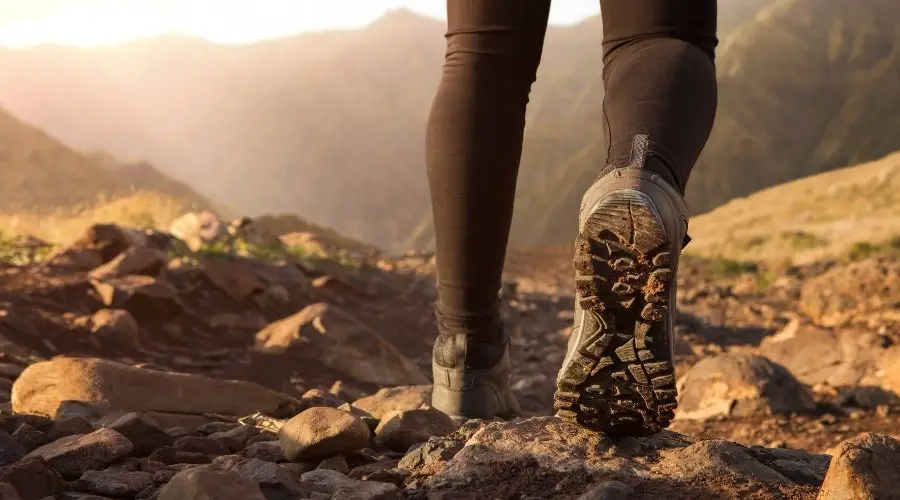Approach shoes, hiking shoes, and trail running shoes are pretty similar to each other. Climbers have been known to use each type of these shoes when navigating to the base of their climbing route. Each shoe type has different features that sets it apart from the others that makes it better suited for certain activities.
On average, approach shoes are the lightest, stickiest, and the best for scrambling. Hiking shoes are typically heavier, more durable, and the best for walking long distances. Trail running shoes are typically a middle ground between approach and hiking shoes which are best used for running.
Knowing the main differences between the shoes will help you decide which type is best for you. Buying the wrong type of shoe not only can cause you to waste money, but it could potentially be dangerous. The article below explores the main differences between the shoes and will allow you to make the best decision for yourself.
Main Differences Between Approach, Hiking, and Trail Running Shoes

There are four main factors that highlight the main differences of these shoe types. They are:
- Sole material and lug design
- Support
- Comfort and durability
- Weight
Each of these factors play a large role in the function of the shoe and its ideal use.
Before we dive too deep into these, it should be mentioned that not every shoe model is the exact same in each type. There will be specific approach shoes that are closer to climbing shoes and others to trail runners.
The same can be said about trail runners. Some of them will be more similar to approach shoes and others will be more similar to hiking shoes. To see what I mean, you can check out the YouTube video below that shows different types of approach and trail running shoes.
As mentioned above and shown in the video, shoes in each type are more on a spectrum than anything. The discussion below addresses the main differences between the shoes type based on the “typical” shoe type. Obviously, you will be able to find shoes that are exceptions to each of these differences.
Sole Material and Lug Design
Approach shoes are designed to have a sticky rubber sole similar to that of climbing shoes. They typically will have small lugs and the rubber will wrap around the toe and sides of the shoe. This sticky rubber is great for traversing dry rocky areas that require precise foot placement.
That said, the smaller lugs of the approach shoes do not typically handle water or icy conditions very well. Because these shoes are commonly used to get to a rock climbing route, this is not a big deal. Rock climbers do not typically climb in the rain or very cold winter months.
Trail running shoes on the other hand are typically designed to have a thicker, less sticky rubber sole with larger lugs. The lug pattern of trail running shoes will typically be more complex than approach shoes to provide runners with traction on every portion of their foot. This allows them to handle everyday use and weather conditions better than approach shoes.
Hiking shoes have the thickest sole of the three and the deepest, largest lugs. On average, the lug pattern of hiking shoes is even more complex than trail runners. This provides hikers with the ability to handle almost every type of terrain and condition they may encounter.
Amount of Support
The shoes are placed in order below from most to least amount of support provided.
- Hiking shoes
- Trail Runners
- Approach shoes
Hiking shoes provide the most support of the three. Not only do they have the thickest sole rubber and cushioning, they will have the thickest upper material and ankle support.
Trail running shoes provide good support but not as much as hiking shoes. They sacrifice some ankle support to allow for easier running and a greater range of motion.
Approach shoes are less supportive than hiking and trail running shoes. This is because they are designed to provide a lot of maneuverability on vertical rocky terrain. They sacrifice support to provide increased foot sensitivity and a greater range of motion.

Shoe Durability and Comfort
The shoes are placed in order below from most durable and comfortable to least.
- Hiking shoes
- Trail Runners
- Approach shoes
Hiking shoes are by far the most durable and comfortable. They were designed to stand up to walking hundreds of miles at a time. On average, they have very thick rubber soles to handle the miles of uneven terrain, are waterproof to stand up to trail and weather conditions, and are amply cushioned.
That said, the durability and comfort of trail running shoes is no joke either. These are also designed to handle incredibly long distances on uneven terrain. They just typically wear out a bit quicker than the heavier duty hiking shoes.
While approach shoes are not typically quick to wear out or uncomfortable, they do not provide the durability and comfort that trail runners or hiking shoes do. To see how long approach shoes typically last and how to make them last longer, check out my article here.
Shoe Weight
The shoes are placed in order below from lightest to heaviest.
- Approach shoes
- Trail runners
- Hiking shoes
Because hiking shoes are designed to be very supportive and handle a large amount of wear and tear, they are naturally the heaviest.
Trail running shoes are typically lighter than hiking shoes to take stress off of a runner’s legs and joints. They are not incredibly light however because they still need to provide runners with support to handle uneven terrain.
Approach shoes are by far the lightest of the three. This is because they sacrifice durability and support in order to provide increased grip and a larger range of motion.
Ideal use For Each Shoe Type
The following characteristics of the shoes discussed above makes them better suited for different activities. These three activities are scrambling, hiking, and running.
The ability of each shoe type for each activity is ranked from best to worst in the table below.
| Shoe Type | Scrambling/Climbing | Hiking/Backpacking | Running |
| Approach Shoes | Best | Worst | In between |
| Hiking Shoes | Worst | Best | Worst |
| Trail Runners | In between | In between | Best |
The performance of each shoe type is discussed in greater detail in the sections below.
Scrambling Performance of Each Shoe Type

For those of you unsure of what scrambling is, you can think of it as a middle ground of rock climbing and hiking. Scrambling typically involves navigating rocky terrain that is steep enough to require the use of your hands.
Many rock climbing locations require the climbers to first scramble up rocky areas and boulder fields to reach the routes. Approach shoes were designed with this purpose in mind.
They are made to have a sticky rubber on the toe and sole of the shoe to give scrambler’s increased grip on the rocks. Their lightweight allows climbers to save energy on the approach and save it for the climbing.
While trail running and hiking shoes can be used for scrambling, they are not ideal. They typically have a rubber material that is more durable and less sticky. This allows them to handle more wear and tear but detracts from their ability to stick to the smaller foot holds that scrambling requires.
That said, trail running shoes will generally be better than hiking shoes for scrambling. This is because they are lighter and will give the scrambler better range of motion in their ankles to handle the steep terrain.
If you are wondering if getting a pair of approach shoes would be worth it for you, check out my article that walks you through exactly when approach shoes are worth it.
Hiking Performance of Each Shoe Type

Hiking shoes are the clear cut best shoe type for hiking and backpacking. They are the most durable, comfortable, supportive, and have the best traction. Not much else to say here.
While hiking shoes are clearly the best, trail running shoes perform perfectly well for hiking. They still provide hikers with support and traction to navigate uneven terrain for long distances. They just are not as supportive, comfortable, or durable. They are better suited for running but will still be effective as hiking shoes.
Approach shoes are able to double as hiking shoes but just are not ideal for it. They are not able to handle the different terrain conditions as well and will not provide the durability, comfort, or support that hiking and trail shoes do.
That said, they can be used for short hikes (less than 5 miles) just fine. I recommend against using approach shoes for longer hikes because they will start to hurt your feet after a while and their stickiness will wear out. I think it is a good idea to wear hiking shoes or trail runners and save your approach shoes for scrambling areas or large boulder fields to get the most out of them.
Running Performance of Each Shoe Type

Trail running shoes are without a doubt the best to use for running. It is what they were designed for after all. They provide trail runners with the support and traction they need while still maintaining the shape, performance, and light weight you want in a running shoe.
Approach and hiking shoes can be used for trail running but are definitely not ideal for it. In fact, I do not recommend trail running in either of these.
Approach shoes will not provide trail runners with the durability or support that they need for running long distances on uneven terrain. In addition to this, the stickiness of them will be wasted on non-scrambling activities.
Hiking shoes on the other hand are too heavy and are designed for walking. Wearing these for running will put additional stress on and strain the trail runner’s lower body joints, ligaments, and tendons (ankle, knees, hips).
If you are in the market for new trail running shoes, I recommend checking out my favorite pair as seen on Amazon here.
The Bottom Line?
Approach shoes will provide you with the most sensitivity and stickiness to handle intense vertical rocky terrain. Hiking shoes are best suited for long distance hikes over uneven terrain that require a lot of support, comfort, and durability. Trail running shoes are a good middle ground between the two and are very versatile.
Personally, I recommend using trail running shoes or hiking shoes in conjunction with approach shoes. Save your approach shoes’ stickiness and precision for when you need it.
